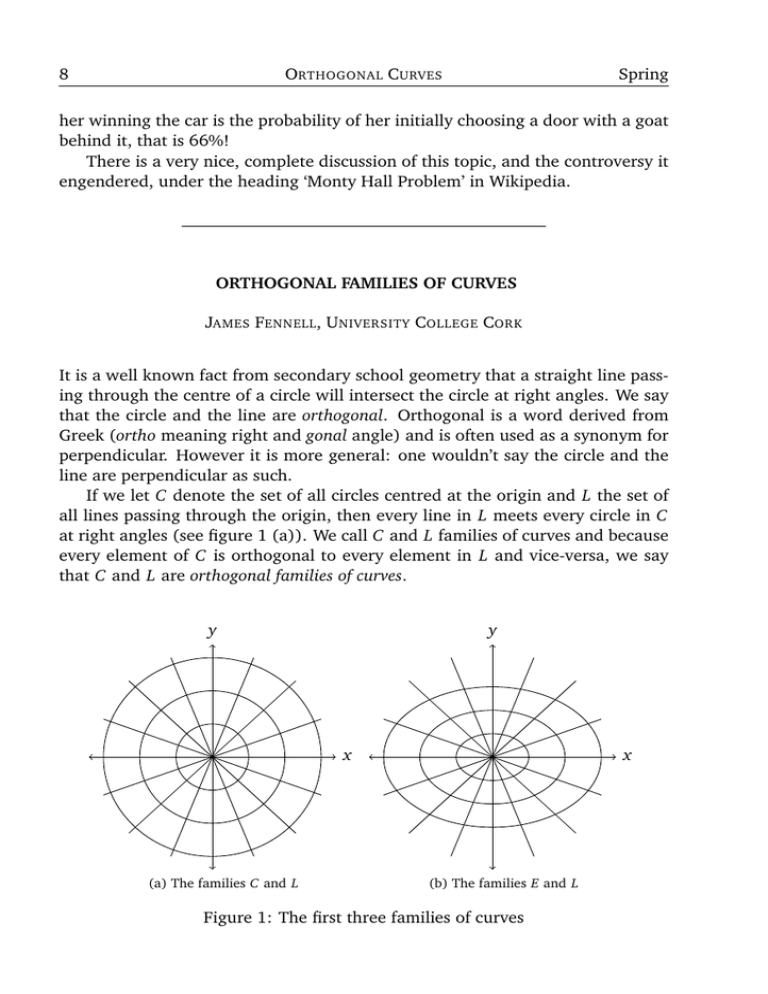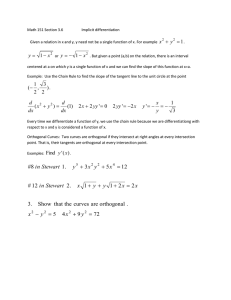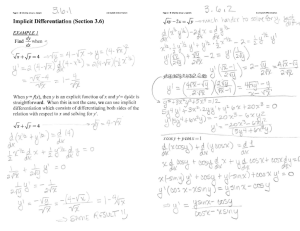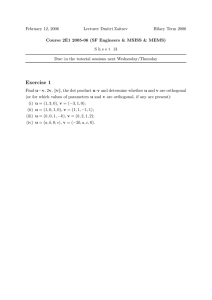8 O C Spring
advertisement

8
ORTHOGONAL CURVES
Spring
her winning the car is the probability of her initially choosing a door with a goat
behind it, that is 66%!
There is a very nice, complete discussion of this topic, and the controversy it
engendered, under the heading ‘Monty Hall Problem’ in Wikipedia.
ORTHOGONAL FAMILIES OF CURVES
JAMES FENNELL, UNIVERSITY COLLEGE CORK
It is a well known fact from secondary school geometry that a straight line passing through the centre of a circle will intersect the circle at right angles. We say
that the circle and the line are orthogonal. Orthogonal is a word derived from
Greek (ortho meaning right and gonal angle) and is often used as a synonym for
perpendicular. However it is more general: one wouldn’t say the circle and the
line are perpendicular as such.
If we let C denote the set of all circles centred at the origin and L the set of
all lines passing through the origin, then every line in L meets every circle in C
at right angles (see figure 1 (a)). We call C and L families of curves and because
every element of C is orthogonal to every element in L and vice-versa, we say
that C and L are orthogonal families of curves.
y
y
x
(a) The families C and L
x
(b) The families E and L
Figure 1: The first three families of curves
2012
ORTHOGONAL CURVES
9
These facts were known to Euclid in 300 BC when he compiled the Elements,
though the terminology is modern. In Proposition 18 of Book 3 he proved what
we would now call an existence theorem: he showed that if we start with the
family of circles C then it is possible to find a family of curves that is orthogonal
to C; namely L. We may now ask if the family L unique. That is, is L the only
family of curves that is orthogonal to C?
Now, suppose while pondering this question you put down your copy of the
Elements and go to make tea. When you return you find your dog sitting on
Euclid’s book, and upon shoving him off notice that he’s squashed the whole
thing so that the circles have become ellipses! But your not angry of course,
because it immediately prompts another question: given the family of squashed
circles E centred at the origin, is there a family of curves orthogonal to it? Clearly
(figure 1(b)) lines centred at the origin are not orthogonal. So whereas for the
circles we had a uniqueness question, here we have to start with an existence
question.
It’s worth remarking at this point that the ellipse problem probably wouldn’t
have occured to Euclid. Euclid studied a fixed finite set of curves - straight lines,
circles, conic sections, etc. - and the kind of general question we pose here - is
there any kind of curve satisfying our conditions - wouldn’t have fitted into this
finite paradigm.
1.
A solution
To attempt to answer these questions we recall an elementary fact from analytic
geometry (or coordinate geometry): if we have a line of slope m then any line
perpendicular to it will have slope 1/m. Of course we’re not dealing with two
straight lines; we’re dealing with more general curves as well. But this isn’t an
issue for we know how to get the slope of a general curve like a circle: we just
differentiate it!
We can describe the family of circles centred at the origin like so
C = {x 2 + y 2 = r2|r > 0}
(1)
We differentiate the expression x 2 + y 2 = r 2 with respect to x, being careful to
differentiate y implicitly as we view it as a function of x. So,
d
d 2
x2 + y2 =
r
dx
dx
dy
2x + 2 y
=0
dx
dy
x
=−
dx
y
(2)
10
ORTHOGONAL CURVES
Spring
We have thus determined an expression for the slope of the family C at any
particular point (x, y). But we have actually gotten a little more. Because of
Picard’s Uniqueness Theorem for ordinary differential equations, the differential
equation we have arrived at has exactly one unique solution up to a constant.
And, by the Fundamental Theorem of Calculus, we know that that one solution
is given by the expression we started with, (1) – integration being the inverse
operation of differentiation. Now we wish to employ our fact about slopes. The
family C has slope m = d y/d x at every point (x, y) and so any orthogonal
family will have slope 1/m = 1/(d y/d x). So now to find any orthogonal family
we must solve the expression
dz
dx
=
−1
m
=
−1
−x/z
=
z
x
(3)
where the y variable has been relabeled z to avoid confusion between the different families. Now we can solve this equation very easily as it’s separable:
Z
dz
z
=
Z
dx
x
log(|z|) = log(|x|) + A
=⇒ z = b x
for b any real number. This is precisely the equation describing the set of all
straight lines passing through the origin! But not only have we recovered Euclid’s fact that straight lines are orthogonal to circles, but we have also proved
uniqueness. For the equation (3) is a differential equation just like (2) and so
has the unique solution z = b x. All parts of our derivation maintained uniqueness (that we can reverse the whole process confirms this) and so there is a
one-to-one correspondence between the families C and L: straight lines passing
through the origin are the only set of curves that are every perpendicular to the
set of circles centered at the origin.
With this technique we can tackle the ellipse problem too. There are an
infinite number of families of ellipses centred at the origin, but we will select
E = {x 2 + 2 y 2 = r 2 |r > 0}
This is the family of ellipses whose width is
p
2 time their height. We have, as
2012
ORTHOGONAL CURVES
11
before
d
d 2
x2 + 2 y2 =
r
dx
dx
dy
=
2x + 4 y
dx
dy
x
=−
dx
2y
(4)
and so
dz
=
−1
−x/2z
Z
dx
=2
z
x
dx
Z
dz
=
2z
x
log(|z|) = 2 log(|x|) + A = log(x 2 ) + A
=⇒ z = b x 2
This new family is illustrated in figure 2.
y
y = x2
x 2 + 2 y 2 = 32
y=
1
4
x2
y=
7
100
x2
x
x 2 + 2 y 2 = 42
Figure 2: The family E, ellipses of the form x 2 + 2 y 2 = r 2 , and its unique
orthogonal family, curves of the form y = b x 2 .
Now that we’ve applied the technique twice we might search for general
conditions under which a given family of curves F possesses a unique orthogonal
12
ORTHOGONAL CURVES
Spring
family. We assume the family is governed by an analytic expression of the form
f (x, y, c) = 0
where x and y are co-ordinates and c a parameter that produces different curves
when varied. For the family C the governing equation is
x 2 + y 2 − c2 = 0
However this curve is special in that when differentiate it the constant disappears. If instead we had the family
y = ec x
after differentiation we would still have c in the expression. This needs to be
removed by solving the equation for c and then subbing that into the derivative.
So the full process is: first differentiate f implicitly to find d y/d x as a function
of x, y and c. Then apply the inverse function theorem to ensure that we can
solve f (x, y, c) for c as a function of x and y. We will then have a differential
equation of the form
dy
= g(x, y, c(x, y))
dx
giving the orthogonal equation
dz
dx
=
−1
g(x, z, c(x, z))
We then apply Picard’s Uniqueness Theorem to ensure this has a unique solution
which is precisely the orthogonal family of F .
Theorem 1.1. Let F be an orthogonal family of curves governed by an equation of
the form f (x, y, c) = 0 in U, an open set in R3 . Suppose that ∂ f /∂ y exists and is
never 0 so that, by the implicit function theorem, there exists a function g with
dy
dx
= g(x, y, c)
and g never 0. Suppose also that ∂ f /∂ c is never 0, so that we can write c =
c(x, y). Then F has a unique orthogonal family in U governed by the solution to
the differential equation
dz
−1
=
dx
g(x, z, c(x, z))
2012
ORTHOGONAL CURVES
2.
13
Orthogonality in the complex plane
Our analysis so far has been restricted to the real plane. However there is a
strong argument that the best context in which to explore orthogonality is the
complex plane. To see this, take any complex number z = a+ bi and plot it on an
“Argand diagram” of the complex plane. Now multiply by i to get iz = −b + ai
and plot the resulting complex number on the same diagram. The result is shown
in figure 2. We can see that geometrically, multiplying by i is the same as rotating
the “vector” a + bi π/2 radians counter-clockwise to arrive at a perpendicular
“vector” b + ai. So orthogonality is built-in to the complex numbers!
Im
a + bi
bi
−b + ai
ai
a
−b
Re
Figure 3: The geometric effect of multiplying z = a + bi by i: rotation by π/2
radians.
We wish to draw curves in the complex plane and see if we can find families
of curves that are orthogonal. Let f (z) be a complex function. As we vary z the
value of f (z) will change about the complex plane tracing out a curve. As z is
complex there are an infinite number of ways of varying it - as opposed to a real
number, where one can only increase it or decrease it in the one direction. We
will restrict our attention to complex differentiable functions. Recall that
f 0 (z) = lim
h→0
f (z + h) − f (z)
h
When defining a real derivative h is a real number and so we can approach 0
from the negative side or the positive side. When defining a complex derivative
h is a complex number and so can approach 0 from any direction in the complex
plane. As a result, complex differentiable functions are a little rarer in a sense,
14
ORTHOGONAL CURVES
Spring
but this won’t be an issue here. Now, for h small we can write
f 0 (z) ≈
f (z + h) − f (z)
h
=⇒ f (z + h) ≈ f (z) + h f 0 (z)
This is also the first order Taylor expansion of f . As h is complex we can replace
it by ih and so write
f (z + ih) ≈ f (z) + ih f 0 (z)
We are interested in the local behaviour of f and in particular how f affects the
natural orthogonality of complex numbers discussed above. We take any point
z, a small complex vector h and the perpendicular vector ih. Then we consider
f (z) and two, again perpendicular, vectors h f 0 (z) and ihf 0 (z), at f (z). The
end-points of these vectors will be f (z) + h f 0 (z) and f (z) + ihf 0 (z). Given our
approximations above, these new vectors roughly describe the result of applying
f to the three points z, z + h and z + ih (see figure 4).
Im
Im
f
f (z)
z + ih
ih
f 0 (z)
z
h
i f 0 (z)
f (z) + ihf 0 (z)
≈ f (z + ih)
f (z) + hf 0 (z) ≈ f (z + h)
z+h
Re
Re
Figure 4: The geometric effect of applying a complex differentiable function:
orthogonality preserved.
As we take the limit h → 0 these new vectors become tangents to the two
curves generated as f travels in the perpendicular directions h and ih. Thus if
we apply f to perpendicular lines we will get two curves that intersect at a right
angle.
Remember that we haven’t said anything about f besides that it is differentiable, so this result applies to a large class of functions! In [1] Tristam Neehan
produces a very nice application of this fact to prove two well known curves can
form orthogonal families. We consider the complex cosine function cos(z) and
in particular the identity
cos(x + i y) = cos(x) cosh( y) + i sin(x) sinh( y)
2012
ORTHOGONAL CURVES
15
where cosh and sinh are the hyperbolic trigonometric functions. We now form a
grid in the complex plane formed of vertical lines and horizontal lines. Vertical
lines occur when the real part of z is kept constant and horizontal lines when
the imaginary part of z is kept constant. We take the latter case first. Holding
Im(z) = b constant we have
cos(x + i b) = cos(x) cosh(b) + i sin(x) sinh(b) = Acos(x) + iB sin(x)
for constants A and B. As f traverses a horizontal line it traces out the curve in
the complex plane parameterized like so
(Acos(t), B sin(t))
This is just the usual parameterization of an ellipse in the plane centred at the
origin and with major axis on the horizontal axis. The distance from each foci to
the origin is given by the usual formula
p
p
A2 − B 2 = cosh2 (b) − sinh2 (b) = 1
and so the foci for all of our ellipses are at (−1, 0) and (+1, 0). The family of
curves so generated (as b is varied) is then the family of all ellipses with centre
(0, 0) and foci (±1, 0).
Now, what if f traverses a vertical line? In this case Re(z) = x = a is constant
and we have
cos(a + i y) = C cosh( y) + iD sinh( y)
When we write the curve traced by f in parametric form, as (C cosh(t), D sinh(t)),
we that it is another conic section, the hyperbola! The distance from the origin
to each of the foci is
p
p
C 2 + D2 = cos2 (a) + sin2 (a) = 1
and so the foci are again (−1, 0) and (+1, 0). The family of curves generated by f
traversing the vertical lines in the complex plane is then the family of hyperbolas
with centre (0, 0) and foci at (±1, 0). But, of course, vertical lines and horizontal
lines are perpendicular. We applied a complex differentiable function to each of
these and got a family of hyperbolas and a family of ellipses with the same foci.
By our reasoning above the orthogonality is preserved, and so we have the result
that hyperbolas and ellipses with the same foci intersect at right angles. The two
families are illustrated in figure 4.
This method can be used to find a wealth of orthogonal families. Application
to the complex exponential function yields another proof that circles and lines
are orthogonal. Even applying it to f (z) = z 2 yields an interesting picture –
which is omitted intentionally!
16
ORTHOGONAL CURVES
Spring
y
x
Figure 5: Ellipses and hyperbolas with the same foci.
References
[1] Tristam Needham. Visual Complex Analysis. Oxford University Press, 1997.
ISBN: 9780198534464.
[2] George F. Simmons. Differential Equations. Tata McGraw-Hill, 1972. ISBN:
0070995729.


